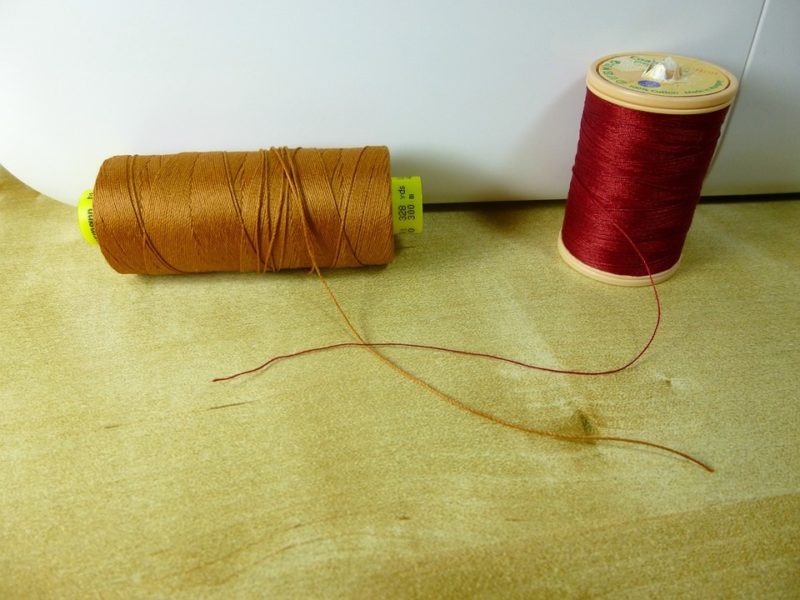The answer to what is a whip stitch in sewing is that it’s a method of joining fabric or even creating a seam. We’ll talk below about why it’s ideal for most sewing projects and if you can do it in the sewing machine. We’ll also compare it to other types of stitches.
Speaking of attaching materials, we wrote a tutorial on how to sew two pieces of fabric together with a sewing machine. Consider reading that guide as it shares tips on creating seamlessly combined materials without the “lips.”

What Is Whip Stitch In Sewing
A whip stitch is a method of joining fabrics or making a seam by creating stitches that circle the edge of the project. The needle will go in and out of the fabric so the finished look has the diagonal stitches wrapping around the edge, similar to what a notebook bound by a spring looks like.
The whip stitch can be used in knitting or crocheting because the stitches disappear into the project for a neater-looking seam. Some sewers even use it as an alternative to the blanket stitch when finishing edges. Furthermore, you can bind applique and join felt pieces with whip stitch because it doesn’t add bulk but still attaches securely without the risk of fraying.
What Is The Difference Between A Running Stitch And A Whip Stitch?
A running stitch is also called the basting stitch, where stitches are long and straight. On the other hand, a whip stitch is short, diagonal stitches, typically invisible on the top of the fabric if needed. Since running stitches are used for basting, they are also meant to be taken out eventually, while a whip stitch is left out for finishing seams or attaching materials.
Whip stitch vs blanket stitch
Similar to the whip stitch, the blanket stitch is often used for finishing the seams of projects. But because it is visually appealing, the blanket stitch is also considered as a decorative seam. It is used on quilts and even in hand embroidery.
Whip stitch vs catch stitch
It’s easy to differentiate a whip stitch from a catch stitch, but both make lines on the fabric edge. However, imagine making a cross or x-shape with your whip stitch, and that will be what a catch stitch looks like. It is also helpful for seaming two fabric pieces or blind hem.
How Do You Do A Whip Stitch?
For joining seams
- Knot the thread end and push the needle through the middle of the fabrics up to the top to hide it
- Bring the needle down through the fabric layers from bottom to top so that it will exit to the hole where you started and secure the stitching row
- Have the needle through the same hole at the bottom and up to the next stitch diagonally
- Bring the needle up underneath the last stitch at an angle so it will come up to the last stitch diagonally
- Repeat the process and then bring the needle up into the middle of the materials to hide the knot
- Separate the fabrics and knot your thread inside
For appliques
- Hide the thread knot between the material and applique
- Alternatively, start underneath the fabric and make a stitch to the top of the fabric, with minimal distance from the edge
- Have the needle diagonally to the edge of the applique, then sew underneath the fabric
- Adjust the angle accordingly and go over the edge consistently
Can A Sewing Machine Do A Whip Stitch?
A sewing machine uses a top and bottom thread, which means doing a whip stitch is impossible. A whip stitch is made by passing a single thread in and out of the fabric, which will be more comfortable done by hand. However, modern sewing machines can produce a whip stitch if indicated, but some only mimic the technique, and others are single-purpose whip stitch machines.
Since the two stitch types are often compared, here is how to do a blanket stitch on a sewing machine.
How Do You Do An Invisible Whip Stitch?
- Use the same thread as the project and thread the needle with a knot at the end
- Hide the knot in the fold of the opening and make a small stitch at the bottom fold from where you came from with the knot
- Pull the thread through and make another stitch from the top fold
- Repeat the pattern of sewing in the top then bottom fold and pulling the thread taut until you reach the end
- Knot off the thread to finish
Read how to sew a hidden seam with a sewing machine if you don’t want to stitch by hand.
What Is The Strongest Stitch By Hand?
The strongest stitch you can do by hand is the backstitch. By working stitches behind the previous ones, you’re making a more durable seam. It is why it’s crucial to backstitch at the beginning and end of each row of stitches.
Conclusion
And that’s it! We just found out what is a whip stitch in sewing, which is a hand-sewing technique that can be used for joining fabrics, appliques, or even seams. It makes diagonal stitches that encircle the fabric edge.
We hope you learned a lot. Also, let us know if you have another sewing technique you’re curious about.
